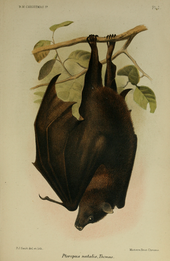Christmas Island Flying Fox Facts

Christmas island flying foxes are vulnerable to loss of feeding and roosting habitat.
Christmas island flying fox facts. The christmas island flying fox is the last remaining endemic mammal persisting on christmas island. They have black or dark brown fur peppered with greyish white hairs. The critically endangered christmas island flying fox is an important focus for conservation on christmas island as it is the last surviving endemic mammal species and probably plays an important ecological role. Some are red or yellow some striped or spotted.
Color varies among the flying foxes. These bats can weigh up to 500 grams. Christmas island flying foxes roost in rainforest trees in camps of up to several hundred. The population is also in decline and under increasing pressure from land clearing and introduced pest.
The large flying fox has the longest forearm length and reported wingspan of any species but some species exceed it in weight. The fruit bat flying fox species pteropus natalis is only found on christmas island its epithet natalis is a reference to that name. Melanotus natalis it may descend from a population of island flying foxes from pulau panjang near java. While our abundant land crabs are the main animal drawcard we also boast incredible birds fantastic marine life and several rare mammals and reptiles.
Flying fox genus pteropus also called fox bat any of about 65 bat species found on tropical islands from madagascar to australia and indonesia and mainland asia. The species is probably the last native mammal and an important pollinator and rainforest seed disperser. Christmas island flying foxes live in the rainforest. Roughly a quarter of the species habitat has been lost since the late 1880s due to mining and other developments.
Some attain a wingspan of 1 5 metres 5 feet with a head and body length of about 40 cm 16 inches. They are the largest bats. The christmas island flying fox or christmas island fruit bat as the name suggests is a flying fox endemic to christmas island it is unclear if it should be considered a distinct species pteropus natalis or a subspecies of the black eared flying fox p. Its wingspan is up to 1 5 m 4 ft 11 in and it can weigh up to 1 1 kg 2 4 lb.
It is believed to have suffered periods of decline in recent decades but the drivers of the decline are not clearly understood.

















